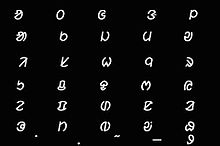Ol Chiki script
This article needs additional citations for verification. (June 2009) |
| Ol Chiki | |
|---|---|
 | |
| Script type | Alphabet
|
| Direction | Left-to-right |
| Languages | Santali language |
| ISO 15924 | |
| ISO 15924 | Olck (261), Ol Chiki (Ol Cemet’, Ol, Santali) |
| Unicode | |
Unicode alias | Ol Chiki |
| U+1C50–U+1C7F | |
The Ol Chiki (ᱚᱞ ᱪᱤᱠᱤ) script, also known as Ol Cemetʼ (Santali: ol 'writing', cemet' 'learning'), Ol Ciki, Ol, and sometimes as the Santali alphabet, was created in 1925 by Raghunath Murmu for the Santali language.
Previously, Santali had been written with the Latin alphabet. But because Santali is not an Indo-Aryan language (like most other languages in the south of India), Indic scripts did not have letters for all of Santali's phonemes, especially its stop consonants and vowels, which made writing the language accurately in an unmodified Indic script difficult. The detailed analysis was given by Byomkes Chakrabarti in his "Comparative Study of Santali and Bengali". Missionaries (first of all Paul Olaf Bodding, a Norwegian) brought the Latin script, which is better[citation needed] at representing Santali stops, phonemes and nasal sounds with the use of diacritical marks and accents. Unlike most Indic scripts, which are derived from Brahmi, Ol Chiki is not an abugida, with vowels given equal representation with consonants. Additionally, it was designed specifically for the language, but one letter could not be assigned to each phoneme because the sixth vowel in Ol Chiki is still problematic.
Ol Chiki has 30 letters, the forms of which are intended to evoke natural shapes. Linguist Norman Zide said "The shapes of the letters are not arbitrary, but reflect the names for the letters, which are words, usually the names of objects or actions representing conventionalized form in the pictorial shape of the characters."[1] It is written from left to right.
Unicode chart
Ol Chiki script was added to the Unicode Standard in April, 2008 with the release of version 5.1.
The Unicode block for Ol Chiki is U+1C50–U+1C7F:
| Ol Chiki[1] Official Unicode Consortium code chart (PDF) | ||||||||||||||||
| 0 | 1 | 2 | 3 | 4 | 5 | 6 | 7 | 8 | 9 | A | B | C | D | E | F | |
| U+1C5x | ᱐ | ᱑ | ᱒ | ᱓ | ᱔ | ᱕ | ᱖ | ᱗ | ᱘ | ᱙ | ᱚ | ᱛ | ᱜ | ᱝ | ᱞ | ᱟ |
| U+1C6x | ᱠ | ᱡ | ᱢ | ᱣ | ᱤ | ᱥ | ᱦ | ᱧ | ᱨ | ᱩ | ᱪ | ᱫ | ᱬ | ᱭ | ᱮ | ᱯ |
| U+1C7x | ᱰ | ᱱ | ᱲ | ᱳ | ᱴ | ᱵ | ᱶ | ᱷ | ᱸ | ᱹ | ᱺ | ᱻ | ᱼ | ᱽ | ᱾ | ᱿ |
Notes
| ||||||||||||||||
